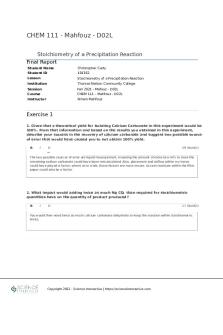precipitation titration.docx DOCX

| Title | precipitation titration.docx |
|---|---|
| Author | Novem Ylayron |
| Pages | 12 |
| File Size | 813.6 KB |
| File Type | DOCX |
| Total Downloads | 93 |
| Total Views | 153 |
Summary
©Ylayron, Tono University of the Philippines Visayas-Miagao campus BS Fisheries Name Ma. Novem Grace Ylayron Date Performed: 03/17/2017 : Jan Linzelle Tono Group No. 8 Experiment No. 4 Precipitation Titration: Determination of Chloride in the sample I Background This experiment aims to determine the...
Description
©Ylayron, Tono University of the Philippines Visayas-Miagao campus BS Fisheries Name: Ma. Novem Grace Ylayron Date Performed: 03/17/2017 Jan Linzelle Tono Group No. 8 Experiment No. 4 Precipitation Titration: Determination of Chloride in the sample I. Background This experiment aims to determine the amount (mg) and % of Cl- (w/w) in the unknown sample through precipitation titration method. Precipitation titrations are based upon reactions that yield ionic compound of limited solubility (Skoog, et al., 2014). Only limited precipitating agents are used because of the slow rate of appearance of precipitate (Skoog, et al., 2014). In this reaction, the analyte and titrant form an insoluble precipitate that can serve as a basis for a titration (LibreTexts.org, 2016). This involved the use of silver nitrate as the reagent, sodium chloride used as primary standard and potassium chromate solution as the indicator. The endpoint was known when there is a change of color observed from yellow of the chromate to the reddish color of silver chromate. Silver nitrate is an important precipitating reagent which can also be used for the determination of the halogens, halogenlike anions, mercaptans, fatty acids, and several divalent inorganic anions (LibreTexts.org, 2016). When silver nitrate is used in titrations, it can be called as argentometric titrations. Potassium chromate can serve as indicator in titrating chloride, bromide and cyanide ions by reacting with silver ions to form a brick-red silver chromate precipitate in the equivalence point region. As the silver nitrate solution is slowly added, a precipitate of silver chloride forms. Ag+(aq) + Cl-(aq) --> AgCl(s) According to the University of Canterbury, the indicator used is dilute potassium chromate solution. When all the chloride ions have reacted, any excess silver nitrate added will react with chromate ions to form a red-brown precipitate of silver chromate. This procedure is known as Mohr's method. 2Ag+(aq) + CrO42-(aq) --> Ag2CrO4(s)...
Similar Free PDFs

Precipitation
- 1 Pages

precipitation titration.docx
- 12 Pages

Victim Precipitation theory
- 2 Pages

Precipitation Reactions Lab
- 5 Pages

Precipitation TEST WORD
- 3 Pages

Moisture, Clouds, Precipitation
- 3 Pages
Popular Institutions
- Tinajero National High School - Annex
- Politeknik Caltex Riau
- Yokohama City University
- SGT University
- University of Al-Qadisiyah
- Divine Word College of Vigan
- Techniek College Rotterdam
- Universidade de Santiago
- Universiti Teknologi MARA Cawangan Johor Kampus Pasir Gudang
- Poltekkes Kemenkes Yogyakarta
- Baguio City National High School
- Colegio san marcos
- preparatoria uno
- Centro de Bachillerato Tecnológico Industrial y de Servicios No. 107
- Dalian Maritime University
- Quang Trung Secondary School
- Colegio Tecnológico en Informática
- Corporación Regional de Educación Superior
- Grupo CEDVA
- Dar Al Uloom University
- Centro de Estudios Preuniversitarios de la Universidad Nacional de Ingeniería
- 上智大学
- Aakash International School, Nuna Majara
- San Felipe Neri Catholic School
- Kang Chiao International School - New Taipei City
- Misamis Occidental National High School
- Institución Educativa Escuela Normal Juan Ladrilleros
- Kolehiyo ng Pantukan
- Batanes State College
- Instituto Continental
- Sekolah Menengah Kejuruan Kesehatan Kaltara (Tarakan)
- Colegio de La Inmaculada Concepcion - Cebu









